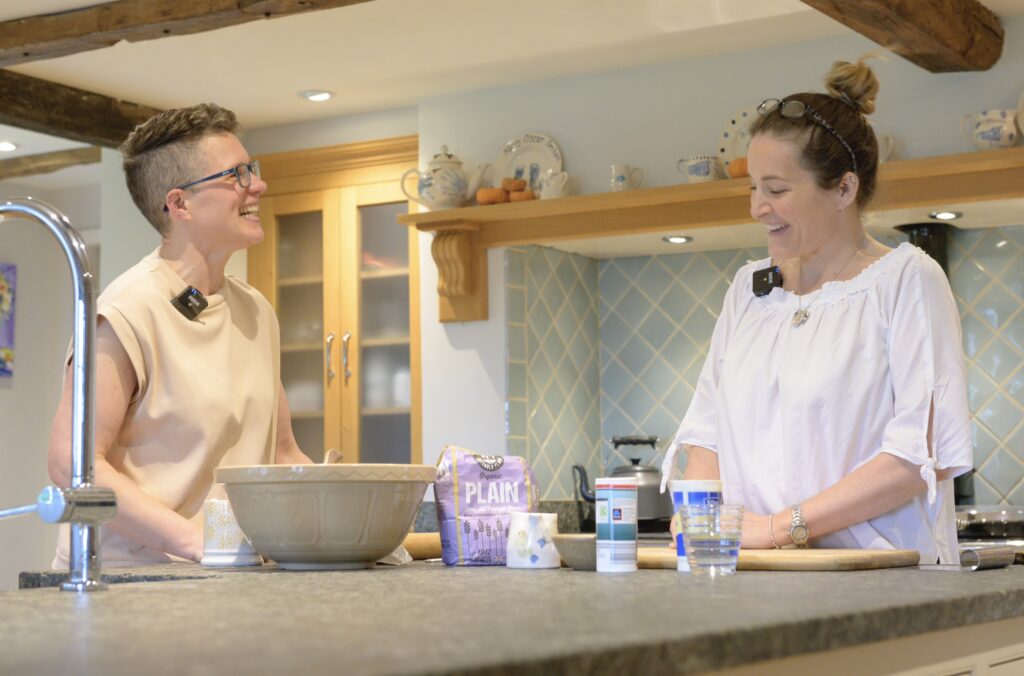
Sourdough hot cross buns! Who wants one? I promise, they’re good!
For these rolls, I use my lighter enriched sourdough recipe from my book The Sourdough Whisperer as my base, and here I have 2 versions: one all white flour, and one wholegrain version.
Sourdough hot cross buns are never going to be as light and fluffy as shop bought yeasted hot cross buns, these have more texture and depth to them, as you’d expect from a sourdough version, plus I did pack in a lot of dried fruit and peel! But, I am very happy to say that each of people that taste tested them (and there was quite a few) gave them a big thumbs up!

Dough notes: please keep in mind that these doughs are slow to fully prove, even without the additions, enriched and milk based doughs are slow growers; add in the dried fruit and peel, and they‘re even heavier; add in the spices and especially the cinnamon, and it slows them down even more. So don’t worry if they haven‘t fully proved in the morning, just leave them and give them a few more hours to do their thing.
My hot cross buns
Makes 12 rolls
Dough Ingredients
White flour version:
50 g active starter
330 g reduced-fat or 2% milk or plant-based milk
1 large egg yolk (reserve egg white for brushing)
50 g butter (I use slightly salted butter), at room temperature
50 g runny honey
500 g strong white bread flour, plus more for dusting
150 g mixed dried fruits and peels
7 g salt, or to taste
1 1/2 tsp ground cinnamon
1/2 tsp ground nutmeg
1/2 tsp ground allspice
Wholegrain flour version:
50 g active starter (I used my wholewheat starter but you can use any starter made with any flour)
330 g reduced-fat or 2% milk or plant-based milk (I used oat milk)
1 large egg yolk (reserve egg white for brushing)
50 g butter (I use slightly salted butter), at room temperature
50 g runny honey
250 g strong white bread flour, plus more for dusting
250 g wholegrain spelt flour
150 g mixed dried fruits and peels
1 tsp salt, or to taste
1 1/2 tsp ground cinnamon
1/2 tsp ground nutmeg
1/2 tsp ground allspice
Note: I used a mix of dried fruit and mixed dried peel, mine included sultanas, raisins, dried cranberries, dried apricots, orange peel and lemon peel.
For the crosses, for use just before baking only
100 g plain/all purpose flour
100 g water
For the glaze, for use after baking only
100 ml water
100 ml honey
Equipment
A medium baking tray lined with parchment paper
Icing bag with smallest nozzle, or sandwich bag with tiny hole cut in one corner
Method
Step 1: In the early evening, in a large mixing bowl, roughly mix together all of the dough ingredients, except the reserved egg white. It will be a very sticky dough, even sticker if you are using the wholegrain spelt flour, and it may be easier to use a bowl scraper or spatula to mix it at this stage. Leave it roughly mixed, cover the bowl with a clean shower cap or your choice of cover and leave the bowl on the counter.
Step 2: After 2 hours, perform the first set of pulls and folds on the dough. Lift and pull the dough across the bowl as far as you can, turn the bowl slightly and repeat, round and round the bowl, until the dough come into a soft studded ball, then stop; it will be a sticky dough, but will eventually easily come into the soft ball. You may find that you have to fold the dough over onto itself rather than pull it and stretch it at this point. Cover the bowl again and leave it to sit on the counter.
Step 3: Over the next few hours, perform three more sets of pulls and folds on the dough, covering the bowl after each set. The dough will remain sticky but will become stretchier, and should come together into a nice soft ball each time. Do the final set before going to bed.
Step 4: Leave the covered bowl on the counter overnight, typically 10 to 12 hours, at 18 to 20°C/64 to 68°F.
Step 5: In the morning, hopefully the dough will have grown to double in size, with a smooth surface. If the dough has not doubled yet, allow it a few more hours to continue to prove. This is a very slow and heavy dough, even heavier than usual with all the added dried fruits, and it may take longer to fully prove.
Once ready to shape, turn the dough out onto a floured surface. Have your lined pan ready. Cut the dough into 12 equal weight pieces. Shape each portion into a smooth ball, and place the dough balls onto the paper lined pan, spaced evenly, with 1-2 cm gaps between them. Cover the pan with a large plastic bag or damp tea towel, and leave it on the counter.
Allow the balls of dough to prove again, letting them grow to double the size. This may take 2 to 6 hours, depending on the temperature of your kitchen.
Step 6: Mix the plain/all purpose flour with the water and stir it until it make a smooth paste. Spoon it into your piping bag. Use a small nozzle or cut a 2mm hole in your piping bag and test piping the paste on your counter, ensure that it holds its line when you pipe some out.
Note: testing the paste before piping it onto the prepared rolls is a tip that I was given from the brilliant Cherie Denham. She also said that if you do test the paste on your counter and it’s too sloppy to hold itself, add more flour to the mix to thicken it up, and then test it again. If it’s holds a nice smooth line, go for it..
Mix the egg white with a tablespoon (15 ml) of water and brush the top of the balls of dough gently with it.
Pipe lines of flour paste across all of the buns to form the crosses.


Step 7: When you are ready to bake, decide whether you would like to bake in a preheated oven or from a cold start. If preheating, set the oven to 200°C (400°F ) convection or 220°C (450°F) conventional.
If you preheated the oven, bake uncovered for 25-30 minutes. If using a cold start, place the uncov-ered pan of dough in the oven, set the temperature as directed and set a timer for 30-35 minutes and bake until the rolls are browned.
Heat the water and honey in a pan over a medium heat, let it simmer and thicken slightly.
Step 8: Remove the pan from the oven and allow the rolls to cool briefly. Brush with the warm honey water to make them shiny. Remove from the pan and place on a wire rack to cool briefly before tucking in!
Note: you can also make a glaze using sugar and water, or there’s various other ways which you can find online.


Eat them warm!!! They’re also great reheated over the next few days 🤩



